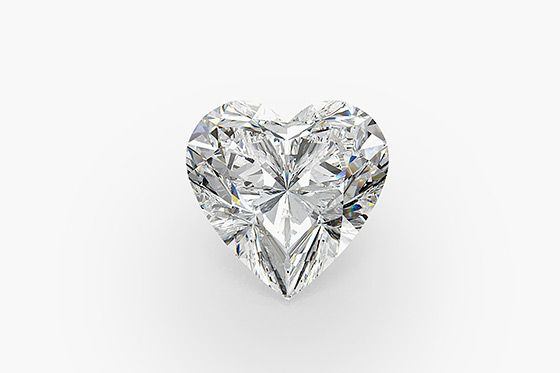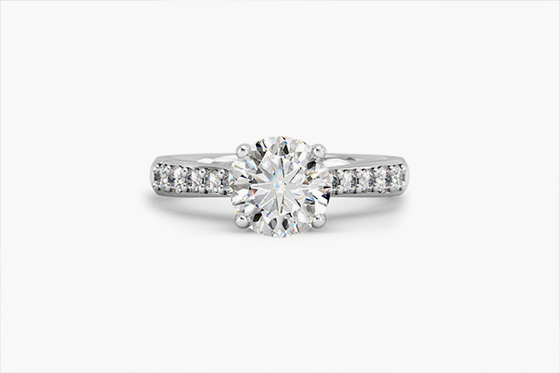The 5 Principles
When purchasing a diamond, there are four significant factors to consider. Each of these factors interact with one another to create the sparkle and brilliance within a diamond.
The Four C’s help you understand the characteristics of the diamond, ensuring you have the highest quality to suit your preference.
The Four C’s consist of: Cut, Colour, Clarity & Carat.
Another principle to understand is that of Fluorescence.
Combined with the Four C’s, Fluorescence makes up the 5 Principles which we recommend looking at when purchasing a diamond.
CUT
When it comes to determining what is the most important aspect when purchasing a diamond, many consumers will look to Colour or Clarity.
Whilst these are generally important characteristics, the Cut of the diamond will ultimately give you the most sparkle.
Cut refers to the diamond’s particular ability to reflect and refract light back up through the top of the diamond, where it emits light through the facet lines in the diamond’s crown.
Several aspects are vital to making this happen for optimum sparkle, and all are considered when a Diamond Grader makes the final assessment on the quality of the cut of the particular Diamond.
Cut is comprised of the Symmetry, Proportions and Polish of the diamond.
Symmetry refers to the symmetrical arrangement of the facets. How well they are aligned will affect how light travels through the Diamond. Simply put, if your diamond is asymmetrical, it won’t have that quintessential sparkle.
Proportions refers to how well the size of each area of the Diamond relate to each other and their ability to return light back to the viewers eye. If the diamond is not proportional, you may have misdirected light meaning reduced brilliance. (e.g. if it the Diamond is cut too deep, it will lose light out of the sides).
Polish refers to the smoothness of each facet and how the diamond has been cut from the rough form. It focuses on the diamond exterior and how well the diamond has been polished. A well-polished diamond can produce crisp reflections whilst a poorly polished diamond can appear dull to the eye.
Each of these factors are graded from Very Poor to Excellent.
Overall, Cut is the most important factor to consider because ultimately, this has the greatest influence on the appearance of the stone.
COLOUR
Colour is usually one of the four C’s that diamond shoppers wish to prioritise. However, when it comes to sparkle, colour doesn’t impact it that significantly.
Ideally, starting from a G upwards in colour will allow you to have a stone which should be visibly white to the naked eye.
A diamond that has a slight yellowish tinge (perhaps an M on the scale, like our example) may appear to exude a slightly less white sparkle, but this again is very difficult to detect and not always the case.
So, with regards to sparkle, a whiter Diamond will “complete the look” compared to a stone with a yellow tinge, however, colour actually has little to do with a diamond’s ability to sparkle.
CLARITY
Clarity refers to the absence of any internal flaws called inclusions or blemishes on the surface. Diamonds are formed under extreme heat and pressure within the earth. As the diamond forms, each one will have different characteristics that may include internal flaws called inclusions and external marks called blemishes.
The number, size and positioning of these flaws and blemishes can affect the value of the diamond, but not necessarily it’s sparkle. Clarity is graded on a scale starting at FL (Flawless) / IF (Internally Flawless) down to I3 (Included).
A diamond with an I3 grading will have inclusions that are detectable to the naked eye and may even affect brilliance. An I3 grading can also mean the stone has durability issues which is not what you would want when purchasing a diamond.
An SI1 grading (Slightly Included), means there are inclusions present within the diamond however, you should not be able to detect these to the naked eye. This is an ideal clarity to consider when purchasing a diamond as you will not detect the inclusions to the naked eye, and as it is not at the top end of the scale, it allows you to spend more on the cut.
In conclusion, clarity and sparkle of a diamond are not necessarily related. You can have great sparkle factor on a diamond which has lower clarity. Here the determining factor is the type of imperfections that the diamond has.
In some cases, certain types of imperfections can impact the sparkle of a diamond but overall if they are well sourced, they will not affect the sparkle and life of the diamond.
FLUORESCENCE
When exposed to UV lighting, diamonds that are fluorescent emit a visible glow, commonly blue in colour.
In rare instances, high levels of fluorescence can make a diamond appear hazy or milky. However, in most cases, fluorescence does not impact the beauty of sparkle within a diamond. With lower colour graded stones (J-K for example), it can make them appear whiter when looking at the stone face up.
CARAT
Carat is the unit of mass used to measure diamond weight.
Traditionally, carob seeds were used as a reference for the individual weight of a diamond. Today, the system has been standardized and a metric ‘carat’ is defined as 200 milligrams.
The size of a diamond often tends to be high on the shopping criteria of many customers. Bigger is better right? Well, only if size is your main priority when purchasing a diamond.
Depending on your budget, you may have to compromise carat weight in order to prioritise one of the other Four C’s.



